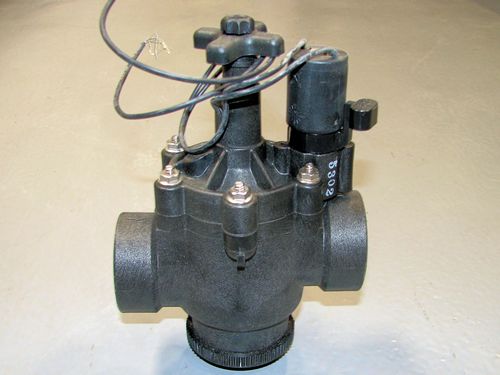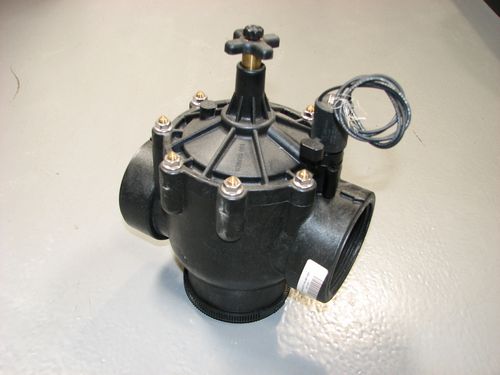Irrigation Product Listings & Reviews
Irritrol 100 & 102 Series Century Plus Valve

Irritrol 100 series valve
Description:
This is one of the most reliable plastic-body valves made, in my opinion. Of course because they are well made they are also fairly expensive, and would be over-kill in most residential yards. Millions have been used on large irrigation systems like parks and schools. These valves have been around as long as I have been in the business and I've never heard any major complaints about them. Like all other valves every once in a while there's a bad one, but not very often. I've used thousands (yes, thousands) of them on large projects like parks, schools, and golf courses.
Name that Valve...
Originally this valve was made under the brand name Hydro Rain. Hydro Rain was bought by Hardie and the valve was rebranded to Hardie. Hardie also bought the Irritrol company, but kept it under the Irritrol name. Then Hardie sold their irrigation division to Toro, with the condition that the Hardie name be removed from all the irrigation products. Toro renamed this valve once again, this time making it part of the Irritrol product line. So if you run across an older sprinkler system, the following brands are all this same valve...
- Hydro Rain 100 series (pre year 2000)
- Hardie 100 series (pre year 2000)
- Irritrol 100 series
Not confused enough yet? There is a new Hydro Rain company, founded in 2005 by the owners of Orbit Irrigation. They grabbed up the Hydro Rain® trademark that Toro foolishly abandoned. So now there are new Hydro Rain branded products on the market that are a completely new product line and not related to the older Hydro Rain at all.
Current Model Numbers:
- Irritrol 100P1
- Irritrol 100P1.5
- Irritrol 100P2
- Irritrol 100P3
- Irritrol 102P1
- Irritrol 102P1.5
- Irritrol 102P2
- Irritrol 102P3
Features of the Irritrol 100 & 200 series valves:
- 200 psi rating
- Manual internal bleed
- Manual external bleed (flush mode)
- Flow control for flow adjustment and manual closing
- Glass-reinforced nylon, stainless steel and brass construction
- Double-beaded, nylon-reinforced Buna-N diaphragm
- Buna-N valve seat seal
- Stainless steel metering pin(externally removable)
- Encapsulated injection-molded solenoid
- Captive hex plunger
- Positive 0-ring seal on inlet plug
- Molded-in and anchored studs allow positive bonnet attachment and removal
- Brass flow control stem (2- and 3-inch models only)
- Easily serviced without removal from the system
- Flow range: 5-300 GPM
- Pressure range: 10-200 psi for 100 model, 10-100 psi for 102 model
- Regulation Option (OmniReg® modular option)
- Electric or manual operation.
- Pressure setting dial.
- Self-modulating pressure regulator maintains constant downstream pressure within ± 3 psi of pressure setting.
- Outlet pressure regulating range from 5-100 psi or 5-30 psi with Schrader valve test port.
- The Omni-Reg® device can be very easily added as a retrofit later if you find you need it.
- Inlet pressure must be 10 psi greater than desired outlet pressure. I suggest it be 15 PSI greater.
- Not compatible with 102 model.
- The 102 model "anti-contamination valve" model has these additional features:
- Electric models have a 150-mesh external control water filter and three-way solenoid.
- Non-continuous metering system for dirty or effluent water applications.
- Small exchange of control water allows minimum filter capacity.
- External water filter allows easy service for cleaning.
- Selectable normally open or normally closed mode (factory set at normally closed)
- Not compatible with the OmniReg® modular pressure regulator.
- Not compatible with latching solenoids.
Review:
This valve is Irritrol's top of the line valve and it has pretty much all of the usual options available (see features above for a list of them). The glass reinforced nylon body has very good durability. Brass valves may be stronger, but in general plastic has a smoother flow, lower cost, and lighter weight. Typically pressure loss is lower through plastic valves than brass valves. While this valve is somewhat sunlight resistant I strongly recommend that it not be installed in the open. If it isn't buried in a box, then put some type of shelter over it. My experience is that all plastic valves will eventually break down in sunlight. With a cheap valve you can replace it when it gets brittle, but with a valve like this one it is much cheaper to just cover it. The flow control stem is brass, not plastic, this makes it much more durable.
The Irritrol 100 and 102 series valves are combination angle/globe valves. They have two inlets, one on the bottom of the valve and one on the side. A plug is installed in the unused inlet. The outlet is in the side opposite the side inlet. Pressure loss through the valve is greater when the side inlet is used (globe style). See the performance tables above.
The 102 model can be used as either a normally closed (like most irrigation valves) or a normally open valve. This means this is the perfect valve for those times when you need a valve that closes when it is activated, rather than opens. Normally open valves are often used with automatic filter flush units.
The globe/angle pattern and ability to be normally open or normally closed makes the 102 series one of the most versatile valves on the market. Few other valves have both of those options available. However the 102 valve does have an external tube which must be protected from damage. If installed above ground the 102 series valve should be protected by some type of enclosure.
The external solenoid water supply tube gives this valve the option of using a separate clean water source to operate the solenoid. This makes the 102 series valve adaptable for use with extremely dirty water. I have successfully used the 102 series for irrigating a driving range with wash water from a fruit packing plant that contained large amounts of fruit pulp in the water. This required a double mainline, one for the majority of the dirty water, and a second one that provided clean water to operate the solenoid. This type of dirty water design should not be attempted as a do-it-yourself project. It requires a lot of careful, knowledgable engineering. The installation of this type of dirty water system requires a top-notch contractor who can listen, understand and follow directions that differ greatly from the normal methods of installation. This type of waste water disposal irrigation system is also extremely high maintenance. In many cases there are better ways to deal with the problem of waste water disposal. The driving range always smelled like rotting fruit, and I believe they eventually gave up on the waste water and went to using normal well water.

3 inch size Irri-Trol 100 series valve
Manufacturer's Performance Data:
| Size | 10 GPM | 20 GPM | 30 GPM | 40 GPM | 50 GPM | 60 GPM | 70 GPM | 80 GPM | 90 GPM | 100 GPM |
| 1" | 4.20 PSI | 3.20 PSI | 4.10 PSI | 7.20 PSI | 10.90 PSI | |||||
| 1-1/2" | 1.60 PSI | 2.30 PSI | 3.60 PSI | 5.20 PSI | 7.00 PSI | 9.20 PSI | ||||
| 2" | 2.10 PSI | 2.70 PSI | 3.30 PSI |
| Size | 100 GPM | 110 GPM | 120 GPM | 130 GPM | 140 GPM | 150 GPM | 175 GPM | 200 GPM | 225 GPM | 250 GPM |
| 2" | 3.30 PSI | 4.40 PSI | 4.80 PSI | 5.60 PSI | 6.50 PSI | 7.50 PSI | ||||
| 3" | 2.50 PSI | 3.00 PSI | 4.10 PSI | 5.30 PSI | 6.70 PSI |
| Size | 10 GPM | 20 GPM | 30 GPM | 40 GPM | 50 GPM | 60 GPM | 70 GPM | 80 GPM | 90 GPM | 100 GPM |
| 1" | 4.20 PSI | 3.10 PSI | 2.70 PSI | 4.80 PSI | 7.90 PSI | |||||
| 1-1/2" | 1.30 PSI | 1.60 PSI | 2.80 PSI | 4.00 PSI | 5.50 PSI | 7.10 PSI | 9.00 PSI | 11.00 PSI | ||
| 2" | 1.20 PSI | 1.60 PSI | 2.00 PSI |
| Size | 100 GPM | 110 GPM | 120 GPM | 130 GPM | 140 GPM | 150 GPM | 175 GPM | 200 GPM | 225 GPM | 250 GPM | 275 GPM | 300 GPM |
| 2" | 2.00 PSI | 2.40 PSI | 2.80 PSI | 3.30 PSI | 3.90 PSI | 4.40 PSI | 5.00 PSI | |||||
| 3" | 1.90 PSI | 2.40 PSI | 3.30 PSI | 4.30 PSI | 5.50 PSI | 6.90 PSI | 8.50 PSI |
Note: Watch your maximum flow rates for pipes. You can get a lot more water through a given size valve than you can through the same size pipe. Therefore it is common to have a 1" valve installed with 1-1/4" pipe going into and out of it. Do not exceed 7 feet/second velocity in the pipes! See the pipe sizing section of the sprinkler design tutorial for more information.
If you use the pressure regulator option ("OmniReg®") on the valve your pressure loss will always be a minimum of 15 PSI even if the chart gives a lower number.
For angle pattern pressure losses contact Irritrol. I have only shown losses for flow rates I consider safe. The 2" and 3" valves can handle flows higher than those shown but you better know what you're doing. Contact Irritrol for more information.